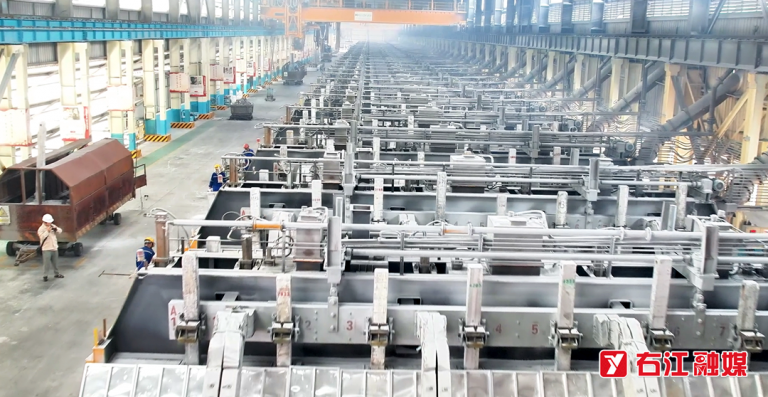
By Zheng Yi, What is “green aluminum?”
People’s Daily recently visited Guangxi Investment Group Liuzhou Yinhai Aluminum Co., Ltd. in Baise, south China’s Guangxi Zhuang autonomous region to find the answer.
In a workshop of the company, dozens of electrolytic cells were seen electrolyzing alumina powder into aluminum liquid meeting purity standards. Every 24 hours, the boiling aluminum liquid would be extracted and sent to downstream foundries.
Over half of the electricity used by the electrolytic cells was clean energy. Thanks to advanced technologies, current efficiency was maintained at 93.5 percent, with comprehensive energy consumption on a downward trend.
By utilizing clean energy, promoting clean production, and enabling carbon footprint traceability, Guangxi Investment Group Liuzhou Yinhai Aluminum Co., Ltd. became the first company in China to have obtained a “green aluminum” carbon label for its aluminum electrolysis project.
Only enterprises that have significantly lowered carbon emissions and pollutant discharge in the production of aluminum can receive this carbon label. The greening of the aluminum industry is the epitome of China’s efforts to advance green and low-carbon transformation.
China is the world’s largest producer of electrolytic aluminum. The production of electrolytic aluminum is electricity-intensive, and that’s why it matters in China’s carbon emission reduction. To achieve the “dual carbon” targets, the aluminum industry must embrace green and low-carbon development.
The “green aluminum” carbon label tracks the total carbon emissions of aluminum products when they are produced, transported, and consumed. This helps strengthen carbon management across the industrial chain, transforming the energy-intensive industry towards an energy-efficient one.
Many clients of Guangxi Investment Group Liuzhou Yinhai Aluminum Co., Ltd. only purchase aluminum alloy plates with the “green aluminum” carbon label. By utilizing clean energy, the company can save 40-50 million yuan ($5.64-7.05 million) in electricity fees annually.
As green development becomes a societal consensus, proactively developing green technology and products is also an industry consensus. Taking green transformation and upgrading as a priority and nurturing green and low-carbon industries not only enhances the development potential of enterprises but also shapes the global competitiveness of the Chinese aluminum industry.
To seize the initiative in green transition requires the strength of technology. Digitalization and intelligentization can play vital roles in facilitating green and low-carbon development.
In digitally upgraded workshops, industrial software and relevant equipment can be used to collect energy conservation data from electrolytic cells and smart meters. By constructing abstract models, manufacturing data visualization can be achieved in relevant applications.
Properly harnessing technological tools and upgrading manufacturing equipment can empower green transitions. By vigorously innovating and digitalizing production management, enterprises can make carbon reduction effects measurable, traceable, and assessable. This not only injects momentum into the transformation and upgrading of traditional industries but also strengthens the foundation for improving carbon emission accounting systems.
The aluminum industry chain is being extended in Baise, Guangxi – scrap edges and corners from aluminum processing are re-melted and shaped into aluminum ingots and rods; metallic iron is extracted from solid waste of alumina production and made into construction materials and roadbed materials.
Recycled aluminum and relevant derivatives have made aluminum recycling a “green recycling,” strengthening weak links in the industry, expanding the circular economy, and forming new competitive edges.
This proves that green development aims to achieve maximum economic and social benefits with minimum resources and environmental costs, and it upgrades the entire industrial chain.
Transformation and upgrading are mandatory for corporations, pivotal for industrial economies, and critical breakthroughs for regional development. The transition of the traditional aluminum industry is guided by green, low-carbon, and high-quality development, supported by digital and smart production management models, and advanced by the amplified value of the circular utilization of resources.
Nowadays, both solar panels on rooftops and wind turbines in forests are injecting “green electricity” into Baise’s aluminum industry. Pursuing green and low-carbon development and following a whole-industrial-chain perspective, China’s aluminum industry will achieve greater success in green transition.










